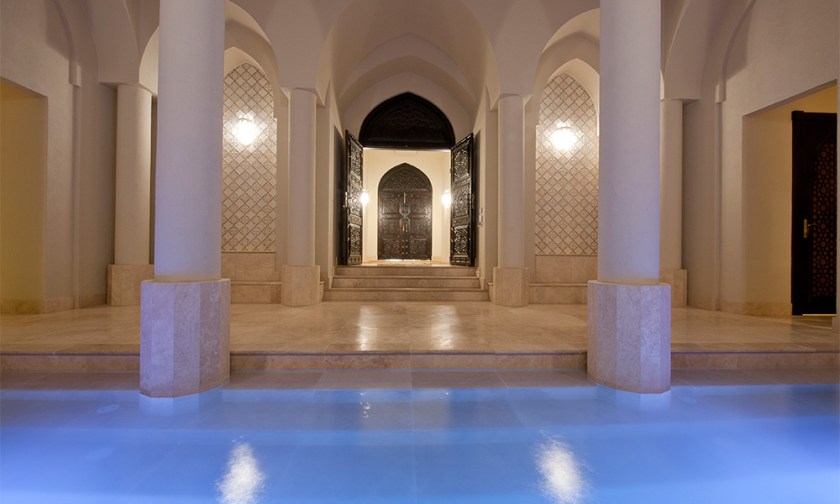Off a bush road in the Dandenong foothills of Victoria, an oasis of exotic pleasures awaits. Forty-five minutes by train from the centre of Melbourne and a 15-minute drive from semi-rural Lilydale, I arrive in Morocco, via Bali and Japan.
I’m here to spend the day at Spa de Marrakech and Roman Bathhouse (latter pictured above). Around the world in 60 minutes, if you like.
I have never been to Morocco, much as I hanker to. Then again, neither have Deborah Quitt or her partner Mark Stewart, who have created this extraordinary oasis in Montrose, a bushy outer suburb and home to a museum dedicated to author May Gibbs, creator of the Gumnut Babies.
In these unlikely surroundings, the idea to craft what I can only imagine is a spa experience as authentic as you’d get this side of northern Africa (with due thanks to ancient Rome, from where the rituals emanated) came to Deborah in a “light bulb” moment, just as the Japanese and Balinese retreats that co-exist on the property.
“I had no background in spas but nearly 15 years ago the idea just came to me that I should create a Japanese garden and retreat, a place for mindfulness and meditation,” she says.
“A few years after that I had a vision to create a Balinese guesthouse, the like of which a bride would want to spend her wedding night in.
“And then came the idea for Spa de Marrakech. I can’t explain it any better than that, but the ideas were so strong and compelling I couldn’t ignore them.”
Fulfilling these visions hasn’t been without hardship. The latest addition to this multi-cultural wonderland opened for business in January, two or more years later than planned.
Opposition from locals with ensuing legal battles, and problems with building works have taken a toll emotionally and financially. But Deborah and Mark have never been tempted to … well … quit.
![SDM-Pink-and-Gold-treatment-room[4]](https://spaandclinic.com.au/wp-content/uploads/2015/10/SDM-Pink-and-Gold-treatment-room4-750x450.jpg)
“It’s true I haven’t been to Morocco, or indeed Bali or Japan – of course I hope to one day – but I have spent hundreds of hours online doing research and pouring over books, learning everything I can about the culture and traditions, the architecture and interiors of these fascinating places steeped in such long and rich history.”
The result is a wonder to behold beyond the ornate brass-reinforced Moroccan-made doors of the Spa de Marrakech “temple”, guarded by stone camels from Egypt.
On what was a scorchingly hot and windy day, stepping inside is indeed entering another world.
The building has lofty ceilings and fresh marble tiled floors; all is calm, cool and quiet.
In the tradition of the best of Arabic healing rituals, Spa de Marrakech offers traditional Moroccan treatments and products, including the Oriental Hammam Ritual, and the experience of a traditional Roman bathhouse.
For centuries, weary travellers of the caravan went to traditional hammams [the Ottoman variant of the Roman bath] for bathing and cleansing rituals after long journeys, as well as for the social aspects.
These rituals have been replicated for guests with appropriate modern twists.
To one side of the spacious reception area is the Moroccan relaxation lounge containing private dining alcoves, where guests can enjoy traditional cuisine from the spa’s award-winning chef, Michael. It was serendipitous that he decided to settle in a nearby town in 2014 after a career that’s seen him cook for restaurants and resorts around the word – and Moroccan cuisine happened to be his specialty. He also provides the menus for the Japanese and Balinese retreats.
Spa guests have the option of eating between treatments, lunch or dinner, with choices including harrira soup, Persian love cake and tagines. Or they may simply enjoy complimentary Moroccan mint tea with a selection of traditional sweets.
Every finishing touch throughout the complex, from the imported Moroccan tiles and German-manufactured massage and shower beds, to the Arabic lanterns, exotic hand-painted murals, framed tapestry and hand-crafted mirrors sourced from Egypt, Morocco, Dubai and Syria through agents and scouts, show that no thought or expense has been spared.
![SDM-Moroccan-Lounge-2[3]](https://spaandclinic.com.au/wp-content/uploads/2015/10/SDM-Moroccan-Lounge-23-750x248.jpg)
And so to that bathhouse, the source of aforementioned building glitches and unforeseen extra expense – but oh so worth the ordeal to this visitor.
Through more large ornate carved doors, past two massage rooms with ensuite steam rooms that also offer colour therapy, is the communally-designed heated mineral indoor pool surrounded by more murals.
In this complex-within-the-complex there are two separate twin-head shower rooms and a private steam room, colour therapy and an ice fountain with which to cool off between steamings.
“Our passion is to provide unique thermal mineral bathing, whose origins are partly in ancient Roman or Ottoman bath culture and are enjoying a golden age revival today,” says Deborah.
“The benefits of thermal bathing are widely recognised and have been part of preventative health and wellness routines around the world for centuries.”
From the two-hour Desert Journey to the four-hour Goddess Ritual, the Spa de Marrakech packages promise to “purify the body and relieve the mind, leaving you feeling like you’ve lived the life of Moroccan royalty”.
“We offer a holistic approach to mind and body. The treatments have been designed to be ritualistic and traditional, incorporating sensual and aromatic elements such as desert sand, jasmine and mint,” says Deborah.
![SDM-Steam-temple-without-colour-therapy[2]](https://spaandclinic.com.au/wp-content/uploads/2015/10/SDM-Steam-temple-without-colour-therapy2-300x450.jpg)
She points out that using and selling Le Sens de Marrakech products, exquisitely packaged in handblown glass and silver filigree, also helps keep local Moroccan women in employment.
The other spa brand used is Deborah’s longtime favourite, the English organic Aromatherapy Associates.
On the menu are luxurious massages (with or without the Roman Bathhouse in the package), Hammam rituals (scrubs, treatments and full body pampering), colour therapy (Ayurvedic healers, chromatherapy or colour therapy on the body’s seven chakras) and two types of facials, Radiant Date or Aromatherapy.
The décor inside the massage/treatment rooms – glittering tiles from floor to ceiling, indeed on the floor, too, while the domed ceilings are sprinkled with star lights – is soexquisite as to be almost distracting.
I was given the “gold” room; the other is a luscious pink.
On the menu for me that day was 90 minutes of sheer delight, the Oriental Hammam Ritual. A full body scrub incorporating desert sand with aromatic oils is followed by slathering myself from a bowl provided of therapeutic white mud and simmering for 15 minutes in the steam room. Not for the faint-hearted, that part.
After showering off, I was then given a 50-minute traditional massage.
Somewhat groggy after the sensory sensations and draped in a signature robe (designed and made overseas of waffled cotton selected by Deborah after painstaking research), I wrapped up my visit with the other menu, a traditional three- course Moroccan lunch.
The salmon tagine, assorted traditional sweets and savoury nibbles were utterly delicious but, after being scrubbed, slathered, kneaded and steamed for an hour and a half, all I could do was nibble.
These are the things you regret when offered crackers and cheese for dinner on the flight home to Sydney.
SPADEMARRAKECH.COM.AU; JAPANESERETREAT.COM.AU; BALINESERETREAT.COM.AU




